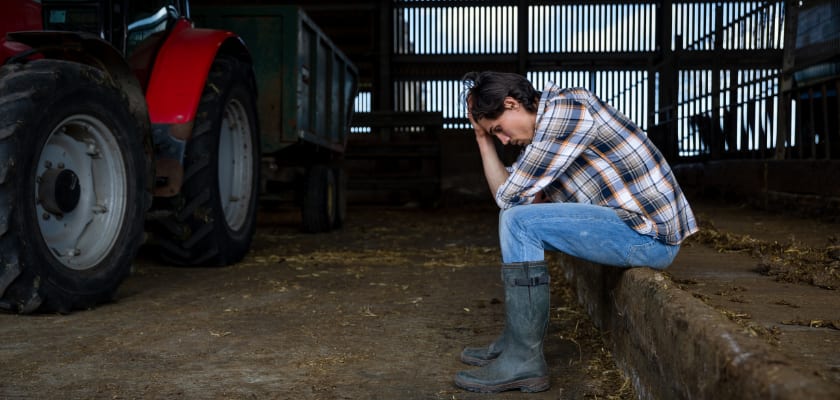If an injury occurs on your farm, who is responsible? Find out

Originally published in Milk Producer.
Consider this scenario. You recently hired a new worker to help with relief milking. On the fourth day, she gets kicked by a cow and suffers a concussion. As the farm operator, are you directly liable for this injury? “That depends,” says Ryan Dick, Health and Safety Consultant with Workplace Safety and Prevention Services.
“The employer has a legal responsibility under the Occupational Health and Safety Act (OHSA) to inform workers about the hazards they will encounter at work and how to control them,” says Ryan. “So, in the above scenario, the employer should be able to demonstrate that the new worker was informed about the hazards of working with livestock, trained on how to safely handle large animals, and have documented training records available. If those things were not done, then the employer did not fulfill their responsibilities under the OHSA. They can not demonstrate due diligence.”
What are the employer’s responsibilities?
The OHSA outlines the legal responsibilities of all employers, including farm operators with employees. For a detailed list of duties, check out Sections 25 and 26 of the OHSA. Ultimately, the employer is required to take every reasonable precaution to protect workers. “This means that farm operators are responsible for protecting their employees from all hazards, whether or not they are specifically mentioned in the legislation,” says Ryan. Demonstrating due diligence means you are able to prove that you have taken every reasonable precaution to protect your workers.
Ryan goes on to discuss confined spaces as an example. The Regulation for Farming Operations (Reg O. Reg 414/05) does not specifically mention confined spaces. However, if you, as an employer, ask one of your workers to enter a confined space, the expectation for due diligence is that the worker will have received the required training, is following an established safe work procedure, and has the necessary equipment to do the job safely.
“Again, employers are required to inform workers of the hazards they may face and provide training,” says Ryan. In the case of working in a confined space, every reasonable precaution would include providing approved training, obtaining records of that training, completing an adequate hazard assessment of the area, and establishing written procedures for controlling the hazards and completing the task. “It’s important to have documentation to show that training and assessments have been completed,” says Ryan. “It’s part of being able to demonstrate due diligence.” He recommends keeping training records onsite and organized so that they are easily accessible if requested.
What is a competent supervisor?
Section 25 of the OHSA outlines an employer’s duties related to health and safety. One of those duties is to provide supervision by a competent supervisor. “A competent supervisor is someone who is qualified because of knowledge, training, and experience to organize the work; familiar with the OHSA and the regulations that apply to the work being done; and has knowledge of actual or potential danger to health and safety in the workplace,” explains Ryan. “All three of those conditions must be met for someone to be a competent supervisor. Unfortunately, that’s not always what I’m finding when I visit farms and speak with the supervisor.”
As the farm operator, if you are going to designate someone to be a supervisor, you should have documentation to confirm that those three conditions have been met (e.g., training records, verified work experience, completed hazard assessments, etc.). “When someone is designated a supervisor, you need to ensure that they understand their responsibilities, as well as the fact that criminal charges could be levied against them for negligence that causes death if those responsibilities are not met,” says Ryan. “You really want to make sure you have the right person and that they understand their responsibilities as a supervisor.”
The supervisor is responsible for ensuring that workers are trained and follow safe work procedures. “Your supervisor is a direct link between you and your workers working safely,” says Ryan. “Telling a worker how to do something and then walking away is not what competent supervision looks like,” he says. Ryan recommends going through the steps of how to perform a task safely, then demonstrating it, and then observing the worker doing it to confirm that they understood. Once completed, keep a record of the training to show that it was done.
Resources and Training
To help farm operators meet their legal responsibilities as employers and supervisors, Ryan recommends the following resources and training courses.
- Health and Safety Awareness Course for Supervisors —This is a mandatory eCourse for all workplaces in Ontario from the Ministry of Labour, Immigration, Training and Skills Development.
- Supervisor Responsibilities and Due Diligence —This is an online, instructor-led course offered by Workplace Safety and Prevention Services.
- Farm Occupational Health and Safety Supervisor Course—This course is offered by the Canadian Agriculture Safety Association.
- Health and Safety Handbook Generator—This free tool will generate a handbook that includes the specific hazards present on your farm.
The information in this article is accurate as of its publication date.




